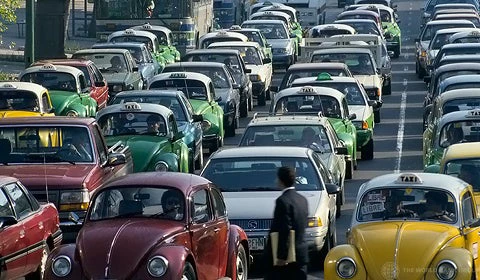Read this post in عربي
The number of vehicles on the world’s roads is on pace to double to about 1.7 billion by 2035. Pair that with a rapidly urbanizing population – six in 10 of us are likely to live in cities by 2030 – and the world’s cities have a transport problem in the making.
It’s also an opportunity, one that cities, particularly the fast-growing urban centers in developing countries, must take now.
Those that build efficient, inclusive urban transport systems can connect their people with jobs, health care, and education. They can reduce congestion, and they can limit carbon emissions that are contributing to climate change.
This is about basic quality of life and more. Fourteen percent of climate changing greenhouse gases come from the transport sector, and 90 percent of urban air pollution is generated by motor vehicles. That air pollution cuts into cities’ productivity and is blamed for the deaths of 800,000 people every year. Another 1.2 million people die from traffic crashes, 90 percent of them in low- and middle-income countries. The infrastructure and policy choices cities make today will lock them into urban development patterns for decades to come, patterns that will either facilitate healthy, economically viable cities or create cities marked by pollution, congestion, and climate change.
Take a drive in Lagos and you’ll see the challenges cities face – and what they can do about them. Lagos, with some 11.2 million people, has locked-in traffic patterns and congested roads that can get thick with pollution. In 2002, the city decided to do something about it. With support from the World Bank, it began work on a bus rapid transport system, the first is sub-Saharan Africa. BRT commuters in Lagos today have reduced their transit time by 40 percent, and fares have dropped 30 percent on average, despite rising fuel costs. Much more must be done, but we’re seeing progress.
 Next week, transportation experts and city leaders from around the world will be meeting at the World Bank for Transforming Transportation 2013. New York City Mayor Michael Bloomberg will join World Bank President Jim Kim for a discussion about shaping the future of urban transportation that you can watch live online. We’ll all be learning from one another’s experiences and ideas during the conference and challenging cities to do better. I encourage you to also share your experiences and ideas with the participants through our World Bank Live website.
Next week, transportation experts and city leaders from around the world will be meeting at the World Bank for Transforming Transportation 2013. New York City Mayor Michael Bloomberg will join World Bank President Jim Kim for a discussion about shaping the future of urban transportation that you can watch live online. We’ll all be learning from one another’s experiences and ideas during the conference and challenging cities to do better. I encourage you to also share your experiences and ideas with the participants through our World Bank Live website.
The meeting is also about financing the transport systems that the world needs. Last spring at Rio +20, the UN Conference on Sustainable Development, the World Bank and the other large multilateral development banks committed $175 billion over the next decade for improving sustainable transport. Government and development experts around the world must now determine how to use that money, and their own funds, in ways that will result in greener, more inclusive, and sustainable cities for the future.
Rachel Kyte
Vice President for Sustainable Development
www.worldbank.org/sustainabledevelopment
Twitter: @rkyte365



Join the Conversation